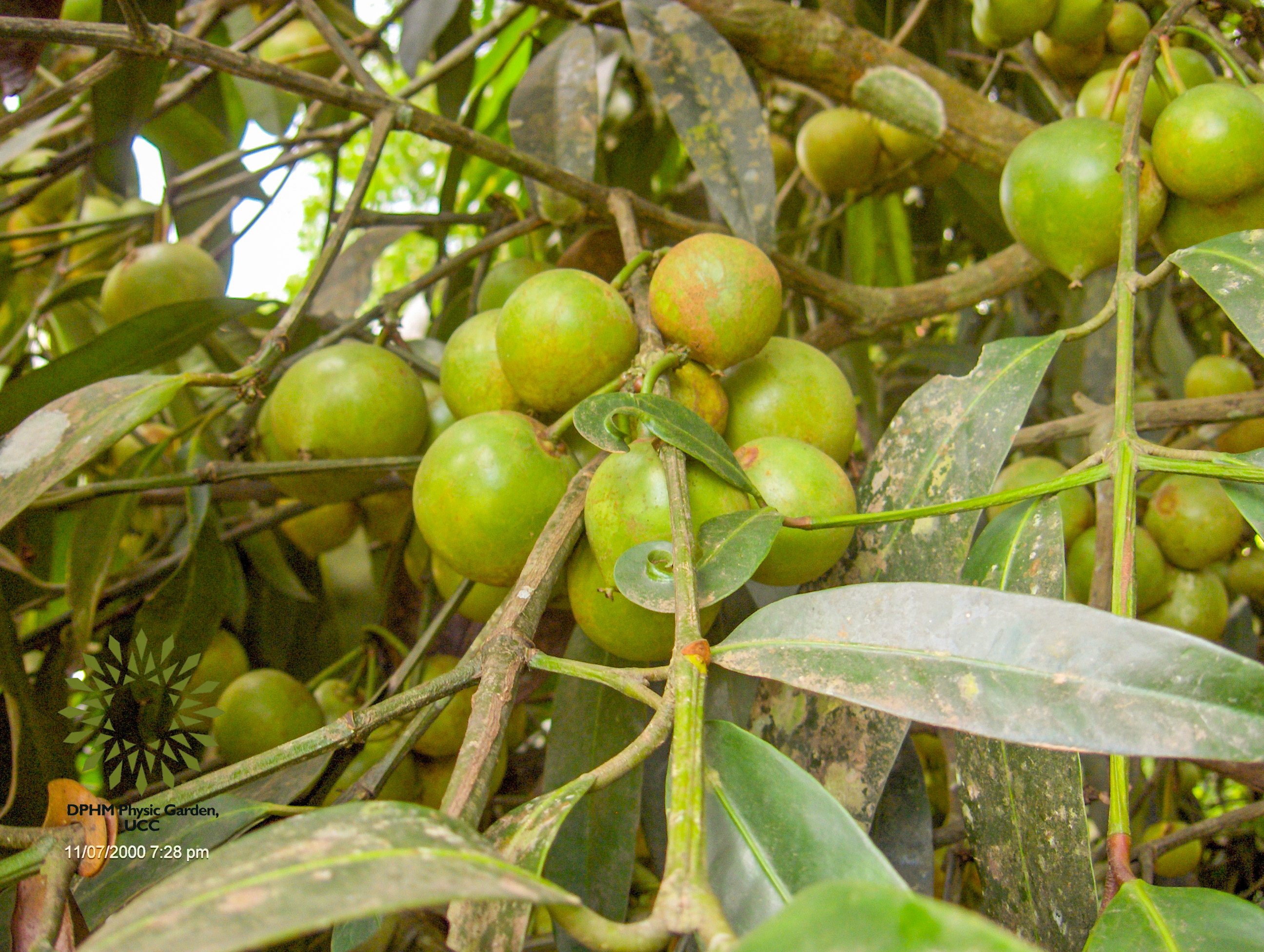MONODORA MYRISTICA
CLASSIFICATION
Order: Magnoliales
Family: Annonaceae
Genus: Monodora
Species: Monodora myristica
BOTANICAL DESCRIPTION
Reaching a height of up to 35 meters, this tree is medium to big in size. Its leaves are simple, alternating, up to 45 cm long and 20 cm broad, and they are elliptic to oblong in shape. The fruit is a huge, globose, woody berry with a diameter of almost 20 cm. Its creamy-white, fragrant flesh is filled with many seeds. "You can eat the fruits and seeds." Scent-wise, the seeds smell like nutmeg.
LOCAL NAMES
Awerewa and Weree(TWI)
Ayiku(Ewe), Awerewain(Fante), Widie abain(Twi)
COMMON NAME
Calabash nutmeg, African nutmeg
ETHNOBOTANICAL USES
The plant's bark and seed are used to treat various ailments, including hemorrhoids, eye conditions, stomachaches, fever, and febrile lumbago. The seed aids postpartum women, manages uterine hemorrhage, and treats stomach discomfort, diabetes, ocular infections, parasite infections, arthritis, anemia, sexual weakness, and malaria. The herb has been used for treatment of dysentery, toothaches and skin conditions. Also, the oil from M. myristica's roots, seeds, and stem bark is used to treat dysentery, helminthiasis, scabies, and malaria.
PHYTOCHEMICAL COMPOSITION
Alkaloids, saponins, tannins, flavonoids, cardiac glycosides, and phenols were among the bioactive substances found in Monodora myristica seeds, according to a phytochemical investigation. Monodora myristica's phytochemical examination showed low concentrations of tannins, phenols, and alkaloids, moderate levels of terpenoids and saponins, and high levels of steroids. A variety of phytochemical substances, such as saponins, tannins, general glycosides, steroids, alkaloids, flavonoids, and triterpenoids, were present in the ethanolic extracts of M. myristica. Compared to other plant parts, M. myristica's bark and seed extracts had a greater variety of phytochemical components.
PHARMACOLOGICAL ACTIVITIES
ANTIBACTERIAL ACTIVITY
Ethanolic extract from Monodora myristica seeds had the most antibacterial activity against pathogenic germs, indicating that it may be a natural antimicrobial agent that may combat drug-resistant pathogens.Significant antibacterial activity was demonstrated by the ethyl acetate-soluble fraction of Monodora myristica seed against a variety of bacteria, yeast, and mould, especially Klebsiella pneumoniae and Escherichia coli. Additionally, the ethyl acetate-insoluble fraction exhibited antibacterial qualities, pointing to possible medicinal uses.
ANTIFUNGAL ACTIVITY
Monodora myristica essential oil demonstrated fungicidal action against isolates of Aspergillus fumigatus, Aspergillus flavus, and Aspergillus niger, with minimum inhibitory concentrations (MICs) ranging from 4x103 mg/L to 5.75x103 mg/L. Also, ethanolic extracts of Monodora myristica, especially from the seed and root sections, showed strong antifungal activities similar to those of the common antifungal medication Clotrimazole.
HEPATOPROTECTIVE ACTIVITY
Monodora myristica extracts demonstrated hepato-protective properties in rats exposed to crude petroleum oil-contaminated catfish meal, increasing protein, albumin, and globulin levels and decreasing liver enzymes. Male Wistar rats exposed to cadmium-induced hepatotoxicity were shown to be protected against it by the aqueous extract of Monodora myristica (MM). Rats exposed to carbon tetrachloride-induced hepatotoxicity showed significant hepatoprotective responses to Monodora myristica seed extract, which reversed antioxidant enzyme decline and reduced lipid peroxidation.
ANTI-OXIDANT PROPERTIES
The acetone extract of Monodora myristica seeds exhibits potent antioxidant effects that augment antioxidant enzymes and elevate reduced glutathione levels in sickled erythrocytes. Also, with an IC50 value of 1829 ppm, the essential oil of Monodora myristica showed only modest anti-inflammatory efficacy and inadequate inhibition of 5-lipoxygenase.
NEUROPROTECTIVE ACTIVITY
In Wistar rats, a hoover gas oil-containing cassava diet caused brain damage. However, Monodora myristica and Glycyrrhiza glabra showed neuroprotective benefits against this injury. With a reduction in HDL-C, AChE, and ATPases and an attenuation of increases in MDA, total cholesterol, TAG, and LDL-C, they successfully corrected altered antioxidants, ATPases, and lipid profiles.
ANTI-INFLAMMATORY ACTIVITY
The methanol extract of Monodora myristica root bark (MME) demonstrated anti-inflammatory properties by preventing xylene-induced mouse ear edema and carrageenan-induced rat paw edema. It did not, however, demonstrate any efficacy against models of chronic inflammation.
CENTRAL NERVOUS ACTIVITY
Monodora myristica (EMM) essential oil could not prevent seizures, but it did considerably postpone the start of seizures in mice when they were caused by pentylenetetrazole (PTZ) and strychnine (STR). This may indicate that extract of Monodora myristica possesses anticonvulsant qualities. Also, in the ketamine-induced sleep paradigm, the extract of Monodora myristica significantly reduced sleep latency and extended total sleep time, indicating hypnotic or sleep-promoting properties.
CARDIOPROTECTIVE ACTIVITY
Extracts from the seeds of Monodora myristica provided protection to rats that developed cardiotoxicity after being fed a diet contaminated with crude oil. While the oil-polluted diet increased oxidative stress and decreased antioxidant enzyme activities, these adverse effects were mitigated by the use of M. myristica seeds as a treatment, with the diethyl ether extract showing the most promise for improvement.
ANTIHYPERCHOLESTEROLEMIC ACTIVITY
Treatment with M. myristica significantly reduced cholesterol levels and improved antioxidant status in hypercholesterolemic rats, suggesting its potential as a therapeutic agent.
ANTI-HYPERTENSIVE ACTIVITY
The essential oil from Monodora myristica fruit seeds, primarily composed of monoterpenoids, demonstrated significant hypotensive effects and reduced cardiac contractions in experimental studies, indicating potential anti-hypertensive activity.
ANTHELMINTIC ACTIVITY
The seed extracts of Monodora myristica and Xylopia aethiopica exhibited significant anthelmintic activity against Eudrilus eugeniae at high concentrations, supporting their traditional use in Ayurveda.
Synergistic action
Cadmium-treated Wistar rats were given a combination of 20 mg/kg of Livolin forte (LF) and 200 or 400 mg/kg of Monodora myristica (MM) aqueous extracts. The combined impact of MM and LF on cadmium-induced hepatotoxicity was demonstrated by the significant reduction in increased levels of bloods biomarkers and oxidative stress indicators as well as the improvement of antioxidant defenses. Again, a lotion that may be used for a variety of eye conditions is made when the bark of Monodora tenuifolia is combined with Monodora myristica.
TOXIC PROFILE
Weanling albino rats in the research showed no harmful effects from Monodora myristica seed oil, suggesting that the oil has promise as an edible. The rats also showed no mortality and good physical appearance. Also, the mice exposed to the flavonoid fraction of Monodora myristica seeds showed a low level of acute toxicity, with an LD50 above 5000 mg/kg body weight. At dosages up to 1000 mg/kg body weight for 28 days, there were no appreciable negative effects on biochemical parameters or the histopathology of the main organs in rabbits used in sub-lethal toxicity experiments. All things considered, Monodora myristica's flavonoid fraction seems to have a good toxicological profile.
CLINICAL VALIDATED USES
Not reported
REFERENCES
Afolabi, F. (2024). Anticonvulsant, anxiolytic and hypnotic effects of Monodora myristica (Gaertn, Dunal.) dried seed essential oil in mice. Nigerian Journal of Pharmacy, 58(1). https://doi.org/10.51412/psnnjp.2024.14
Afolabi, K. D., Eko, P. M., & Etukudoh, E. N. (2024). The Nutritional Value of African Nutmeg (Monodora myristica) Seed Meal. 6(1).
Agiriga, A., & Siwela, M. (2017). Monodora myristica (Gaertn.) Dunal: A Plant with Multiple Food, Health and Medicinal Applications: A Review. American Journal of Food Technology, 12(4), 271–284. https://doi.org/10.3923/ajft.2017.271.284
C, K. F., L, A. A., W, G. A., P, A. F., & P, A. (2016). Phytochemical screening and antifungal activities of crude ethanol extracts of red-flowered silk cotton tree (Bombax buonopozense) and Calabash nutmeg (Monodora myristica) on Candida albicans. Journal of Microbiology and Antimicrobials, 8(4), 22–27. https://doi.org/10.5897/JMA2015.0350
Chinelo C., N., Florence N., N., Innocent U., O., Onyinyechi R., N., Nene O., U., Dawn B, P.-O., & Sunday, O. (2018). Proximate and Phytochemical Analysis of Monodora myristica (African Nutmeg) from Nsukka, Enugu State, Nigeria. Journal of Food and Nutrition Research, 6(9), 597–601. https://doi.org/10.12691/jfnr-6-9-9
Chukwuma, E. R., & Goodness Chiamaka, J. (2017). Ameliorative Effect of the Flavonoid Rich Fraction of Monodora myristica (Gaertn) Dunel Seed Extract against Carbon Tetrachloride-Induced Hepatotoxicity and Oxidative Stress in Rats. Biochemistry & Pharmacology: Open Access, 06(03). https://doi.org/10.4172/2167-0501.1000232
Erukainure, O., Ajiboye, J., Abbah, U., Asieba, G., Mamuru, S., Zaruwa, M., Manhas, N., Singh, P., & Islam, M. (2018). Monodora myristica (African nutmeg) modulates redox homeostasis and alters functional chemistry in sickled erythrocytes. Human & Experimental Toxicology, 37(5), 458–467. https://doi.org/10.1177/0960327117712385
Esiekpe, G. T., George, B. O., Orororo, O. C., Akpede, A. A., Okevwe, G. E., Onotugoma, E., & Oguntola, J. (2020). Monodora myristica seed extracts ameliorate crude oil contaminated diet-induced cardiotoxicity in rats. The Thai Journal of Pharmaceutical Sciences, 44(3), 145–151. https://doi.org/10.56808/3027-7922.2446
Herbal, K. (2020, December 1). TWI NAMES OF SOME PLANTS USED TRADITIONALLY IN GHANA. KENOCH HG HERBAL CLINIC. https://kenochherbal.com/2020/12/01/twi-names-of-some-plants-used-traditionally-in-ghana/
Ibironke A. Ajayi, I. A. A. (2013). Short-term Toxicological Evaluation of Monodora myristica Seed Oil. IOSR Journal of Environmental Science, Toxicology and Food Technology, 3(5), 53–58. https://doi.org/10.9790/2402-0355358
Isiogugu, O. N., Ezike, A. C., Peter, I. E., Onwuka, A. M., Obi, B. C., & Abonyi, U. C. (2018). Effects of Monodora myristica (Gaertn, Dunal.) (Annonaceae) root bark on acute and chronic inflammation.
Jimoh, F. A., Ajao, A. T., Zakariyah, R. F., Odebisi-Omokanye, M. B., & Abdulrahman, H. O. (2020). PHYTOCHEMICAL SCREENING AND ANTIMICROBIAL EFFECT OF SEEDS OFMonodora myristica ON SELECTED MICROORGANISMS. Nigerian Journal of Pure and Applied Sciences, 3674–3686. https://doi.org/10.48198/NJPAS/20.A17
Kemi, F., Oluboade, O., & Josiah, B. (2014). Acute and sub-lethal toxicological evaluation of flavonoid fraction of Monodora myristica Geartn Dunnel seeds. International Journal of Biological and Chemical Sciences, 8(2), 494. https://doi.org/10.4314/ijbcs.v8i2.9
Maduike, E., & Anuna, N. (2018). Infrared Spectroscopy and Microorganisms Associated with African Nutmeg (Monodora myristica) Seeds Sold in a Municipal Market in Imo State, Nigeria. Asian Journal of Research in Medical and Pharmaceutical Sciences, 3(3), 1–7. https://doi.org/10.9734/AJRIMPS/2018/40661
Mbosso, E. J. T., Wintjens, R., Lenta, B. N., Ngouela, S., Rohmer, M., & Tsamo, E. (2013). Chemical Constituents from Glyphaea brevis and Monodora myristica: Chemotaxonomic Significance. Chemistry & Biodiversity, 10(2), 224–232. https://doi.org/10.1002/cbdv.201100378
Nwaozuzu, E., & Ebi, G. (2016). Antimicrobial and Therapeutic Potentials of the Ethylacetate Fractions of Crude Methanolic Extract of Monodora myristica Seed. British Journal of Pharmaceutical Research, 11(5), 1–8. https://doi.org/10.9734/BJPR/2016/23227
Okpoghono, J., Achuba, F. I., & George, B. O. (2018). Protective effect of Monodora myristica extracts on crude petroleum oil-contaminated catfish ( Clarias gariepinus ) diet in rats. International Journal of Veterinary Science and Medicine, 6(1), 117–122. https://doi.org/10.1016/j.ijvsm.2018.03.006
Okpoghono, J., Ukperegbulem, J. K., & Onyesom, I. (2024). Neuroprotective aftermath of Monodora myristica and Glycyrrhiza glabra against cassava diet containing vacuum gas oil induced brain injury in Wistar rats. Toxicology Reports, 12, 244–252. https://doi.org/10.1016/j.toxrep.2024.02.001
Oyinloye, B. E., Adenowo, A. F., Osunsanmi, F. O., Ogunyinka, B. I., Nwozo, S. O., & Kappo, A. P. (2016). Aqueous extract of Monodora myristica ameliorates cadmium-induced hepatotoxicity in male rats. SpringerPlus, 5(1), 641. https://doi.org/10.1186/s40064-016-2228-z
Tsague, I. F. K., Dongmo, P. M. J., Boyom, F. F., Sameza, M. L., Fokou, J. B. H., Bakargna-Via, I., Menkem, E. Z., Zollo, P. H. A., & Menut, C. (2014). Chemical Composition and Biological Activities of Monodora Myristica, Xylopia Aethiopica and Xylopia Parviflora Essential Oils.
INFORMATION, DATA AND PICTURES ARE COPYRIGHT OF DPHM, SCHOOL OF PHARMACY, UCC.



